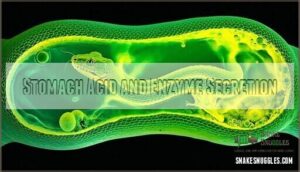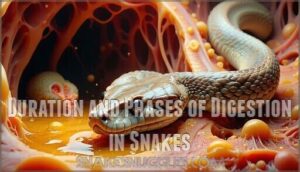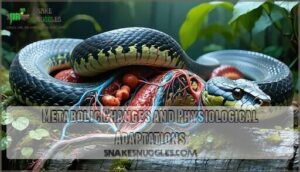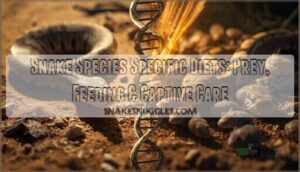This site is supported by our readers. We may earn a commission, at no cost to you, if you purchase through links.
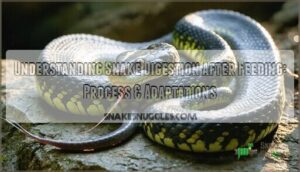
Their bodies shift gears in ways ours never could: muscles contract, enzymes surge, and entire organs spring to life, all tuned for the marathon of digestion that follows.
Understanding snake digestion after feeding is like peeking into a world designed for transformation—one where every cell adjusts to process a banquet with breathtaking efficiency and precision.
Table Of Contents
Key Takeaways
- Snakes can swallow prey much larger than their heads, thanks to flexible jaws, stretchy skin, and specialized muscles that move food down whole.
- After eating, their bodies ramp up metabolism and double gut size, unleashing strong acids and enzymes to break down even bones over several days or weeks.
- Digesting a big meal slows snakes down, making them hide and move less to avoid predators while their bodies focus on digestion.
- Research on snake digestion has inspired medical advances in gut repair and highlights urgent conservation concerns due to habitat loss and other threats.
Snake Digestive System Vs. Human Digestion
You might think snakes digest food the same way you do, but their bodies work quite differently. Both systems share basic organs like a stomach and intestines, yet snakes have evolved specialized adaptations that let them process prey much larger than anything humans could swallow whole.
Let’s look at how their digestive anatomy compares to ours and what makes these reptiles such efficient predators.
Anatomy of The Snake Digestive Tract
When you picture a snake’s insides, you might imagine something alien and mysterious, but the truth is their digestive tract shares more common ground with yours than you’d expect—mouth, esophagus, stomach, small intestine, liver, pancreas, and all the familiar players are there, just arranged for a wildly different dining style.
The esophagus function includes muscular contractions that push prey downward, while the liver’s role and pancreas secretions work together to break down nutrients. Gallbladder importance can’t be overstated—it stores bile for fat digestion. The intestinal structure manages absorption, though snakes’ organs are elongated and efficient.
| Organ | Primary Function |
|---|---|
| Esophagus | Moves prey to stomach via muscular waves |
| Stomach | Secretes acid (pH 1.5) and enzymes for breakdown |
| Liver & Gallbladder | Produce and store bile for digesting fats |
| Pancreas | Releases digestive enzymes into intestines |
| Small Intestine | Absorbs nutrients into bloodstream |
How Snakes and Humans Process Food Differently
You’re probably chewing your lunch right now—that’s job one for your human digestive system, mechanically breaking food into manageable pieces before swallowing. In contrast, snakes skip that step entirely, using backward-curved teeth to grip prey and flexible jaws to swallow meals whole, sometimes larger than their own head.
Your stomach maintains a pH around 1.5 to 3.5 and processes food within 24 to 72 hours. Snake digestive systems, however, drop their gastric pH from 7.5 to 1.5 after feeding, then spend days or even weeks dissolving bones and tissue. Metabolic spikes tell the real story—your metabolism nudges upward after a meal, while snakes experience a 10-fold surge in oxygen consumption.
Feeding frequency differs dramatically too: you need multiple meals daily, but snakes can go months between feedings. Intestinal remodeling in snakes doubles organ mass within 48 hours; your intestines maintain steady structure for nutrient absorption without dramatic reshaping. Snakes achieve this striking feat through extensive intestinal regeneration after feeding.
| Feature | Humans | Snakes |
|---|---|---|
| Swallowing mechanisms | Chewing, rigid jaws | Whole prey, flexible jaws |
| Digestive pH | 1.5–3.5 steady | 7.5 to 1.5 post-feed |
| Digestion time | 24–72 hours | Days to weeks |
Adaptations for Swallowing Large Prey
Snakes pull off something extraordinary—dislocating their jaws and stretching their skin to engulf prey that looks impossibly large, sometimes wider than their own body. Their skull flexibility allows independent movement of jaw bones, while highly elastic skin and an expandable esophagus accommodate the swallowing mechanism. Prey lubrication from mucus eases passage through the snake digestive system.
| Adaptation | Function |
|---|---|
| Jaw dislocation | Allows mouth to open 150+ degrees |
| Skull flexibility | Independent bone movement for large prey |
| Skin elasticity | Stretches to accommodate bulky meals |
| Esophagus expansion | Moves prey to stomach without crushing |
How Snakes Digest Prey After Feeding
Once a snake swallows its prey whole, the real work begins inside its body. The digestive process involves dramatic chemical changes and precise nutrient extraction, with a timeline that can stretch from days to weeks depending on meal size.
Let’s take a closer look at what happens inside the snake, step by step—from the moment food hits its stomach all the way to when it’s finally expelled as waste.
Stomach Acid and Enzyme Secretion
Once a snake swallows its prey, its stomach kicks into high gear, ramping up acid production so dramatically that pH levels plummet from a neutral 7.5 to a corrosive 1.5 in just a few hours.
This hydrochloric acid works alongside powerful digestive enzymes—proteases, lipases, and peptidases—that your snake’s stomach secretes to liquefy muscle, organs, and even bones.
The stomach muscles churn constantly, blending everything into a digestible slurry since snakes can’t chew their food.
Intestinal Absorption and Nutrient Uptake
Once your snake’s stomach has broken down its meal into a smooth, liquid mixture, the small intestine steps in as the main player for absorbing nutrients into the bloodstream.
Here’s a look at how the intestine adapts and manages the nutrient transfer:
- Microvilli double in length within six hours post-feeding, dramatically expanding the absorption surface
- Amino acid uptake rates skyrocket, pulling proteins directly through the intestinal wall
- Nutrient absorption continues for days as the intestines process every usable molecule
- Waste elimination follows, expelling indigestible hair and calcium as compact pellets
This digestion efficiency lets your snake extract maximum energy from infrequent meals.
Duration and Phases of Digestion in Snakes
As soon as that prey hits your snake’s stomach, the digestion timeline unfolds in distinct phases. The snake digestive process ramps up, with metabolic rate soaring for days. Digestion time varies—average meals clear in 3–7 days, but temperature effects and meal size can stretch phases far longer. Snakes also possess flexible lower jaws that aid in swallowing large prey.
Here’s a practical snapshot:
| Phase | Temperature Effects | Digestion Timeline |
|---|---|---|
| Stomach Acidification | Cooler temps delay acid peak | 0–24 hours |
| Peak Digestion | Warmth speeds breakdown | 1–3 days |
| Intestinal Transit | Slow in cold temps | 3–7 days |
| Post-Digestion | Efficiency drops, fasting returns | 7–10+ days |
Metabolic Changes and Physiological Adaptations
After a snake eats, its body springs into action and goes through some truly remarkable changes. Let’s run through what happens on the inside as digestion kicks in.
You’ll start to see some of the most noticeable changes unfold during this process.
Metabolic Rate Increase Post-Feeding
Ever notice how a snake turns mealtime into a full-body power surge? After swallowing a hefty meal, its metabolic rate skyrockets—sometimes up to 44 times normal—driven by a burst in Peak Oxygen Consumption.
Consider this:
- Heart and blood flow ramp up (Organ Responses)
- Digestion runs fully on Aerobic Metabolism
- Energetic Cost: 20–30% of that meal’s energy!
Intestinal Microvillus Growth and Function
Here’s something wild: in just a few hours after a big meal, the snake’s gut lining sprouts new microscopic projections—like rolling out thousands of tiny new fingers just to grab as many nutrients as possible.
This microvilli adaptation nearly doubles nutrient absorption rates, boosts enzyme activity, and accelerates intestinal cell turnover—making the post-feeding response remarkably efficient for nutrient uptake.
Organ Regulation and Energy Efficiency
Imagine if your organs could ramp up, slow down, or even shrink on cue—all to save energy for the next big challenge. That’s reality for a snake:
- Metabolic upregulation kicks into gear post-feeding.
- Digestive organs balloon, then recede—maximizing energy allocation.
- Gut microbiome shifts support efficient nutrient use.
- Physiological regulation ensures adaptive strategies stay finely tuned.
Behavioral and Ecological Impacts of Digestion
After a snake eats, its behavior and habitat choices start to change in some interesting ways. These shifts aren’t just about finding a comfy spot—they can have bigger effects on safety and survival.
Now, let’s explore the choices snakes make during this crucial period.
Post-Feeding Behavior and Habitat Selection
It’s no coincidence that a well-fed snake disappears from view—digesting a big meal isn’t just a physical process, it shapes where and how they spend their days. Postfeeding behavior often means seeking out ideal basking sites for post-meal thermoregulation.
You’ll notice snakes prioritize habitat safety preferences, minimizing movement to conserve energy and evade predators while their vulnerability is at its highest.
Mobility Tradeoffs and Predation Risk
Carrying a large meal changes everything for a snake—post-meal vulnerability is real. Locomotor impairment slows escape, making snakes easier targets for predators. Their behavior shifts: movement drops, cover becomes critical, and predation risk skyrockets. The balance between successful digestion and survival shapes foraging tradeoffs, directly influencing mortality impacts and the natural rhythms of postprandial snake behavior.
- Sprint speed drops sharply post-feeding
- Snakes hide more and move much less
- Larger meals mean longer periods of risk
- Predators exploit this window of impairment
Role in Ecosystem and Invasive Species Dynamics
While a snake might lay low after a big meal, the impact of that feast—on the ecosystem and even entire habitats—can ripple out far beyond the brush where it digests in peace.
Snake digestion shapes prey populations and influences trophic dynamics, and, in invasive species, fuels habitat exploitation. Their postprandial behavior quietly drives ecosystem regulation and foraging patterns, often altering local balances.
Research Insights and Conservation Considerations
As scientists learn more about how snakes digest their meals, new connections are emerging between research, medicine, and conservation. These discoveries illustrate everything from human health to protecting snake populations.
Here are some fascinating ways these findings are making an impact.
Burmese Python as a Digestive Model
In research, the Burmese python is a standout. Thanks to dramatic Organ Mass Changes and an impressive Metabolic Rate Surge after feeding, you see real-time examples of Intestinal Adaptation and Digestive Efficiency.
These pythons provide unparalleled Experimental Utility when studying the snake digestion process, letting scientists trace swift shifts in organs, metabolism, and digestive enzymes throughout the entire digestive system.
Implications for Human Medicine
One thing that fascinates researchers is how the snake digestive system unlocks clues for human medicine. Gut regeneration inspired by python physiology may someday boost treatment for diseases like Crohn’s. Here’s how you benefit:
- Drug development from snake venoms for cardiovascular health
- Metabolic insights for tackling obesity
- Organoid technology enhancing disease treatment and intestinal function
Conservation Status and Threats to Snakes
Even though snakes play an important role in balancing ecosystems, they’re sliding toward trouble. Conservation now faces sharp challenges—habitat loss, illegal trade, and climate change pile up threats against pythons and many others.
Disease threats only add to these extinction risks. Over half of Asian snake species appear on the IUCN Red List, showing just how urgent this issue is.
Frequently Asked Questions (FAQs)
What do snakes excrete after digestion is complete?
After digestion, snakes excrete waste through the cloaca as a semi-solid mass called a pellet.
This waste elimination contains undigested remains like hair, bone fragments, and urate crystals—key details for excretion composition or pellet analysis.
How does temperature affect snake digestion speed?
Environmental temperature variation plays a huge role for coldblooded animals like snakes. Higher temperatures boost metabolic rate, speeding up digestion, while cooler conditions slow it down.
This is why snakes use thermoregulation strategies to improve digestion rates efficiently.
Can illness disrupt a snake’s digestive process?
Imagine a smooth river suddenly blocked by fallen branches—illness can dam up a snake’s digestive system too. Digestive Disorders or upset stomach often slow gastrointestinal processes, disrupting the gut microbiome and requiring slow, careful Recovery Strategies.
Do all snakes digest fur, feathers, or scales?
Not all snakes can completely digest fur, feathers, or scales. These keratin-rich parts resist digestive enzymes, so they’re expelled in pellets.
Digestive efficiency depends on prey composition and evolutionary adaptations across snake species, reflecting fascinating diversity in digestion.
What happens if a snake regurgitates its meal?
Losing a meal mid-process is like dropping half-built scaffolding—regurgitation causes immediate digestive consequences and wasted energy expenditure.
For snakes, undone prey digestion can disrupt the digestive system, upset health, and signals that preventative measures might be needed.
Conclusion
Watch a python resting after a monumental meal, its sides gently pulsing. Inside, a quiet storm rages: stomach acids pour in, enzymes cascade, blood flows to the gut.
The secrets of understanding snake digestion after feeding reveal not just biology, but a strategy fine-tuned for survival. Each gulped meal is transformed with careful efficiency, sustaining weeks, sometimes months.
Snake digestion turns every swallowed meal into a marvel of efficiency, sustaining these ancient predators for weeks and fueling their survival
This ancient process unfolds silently, anchoring snakes firmly within their ecosystem—both powerful predators and striking models of adaptation.
- https://journals.biologists.com/jeb/article/211/24/3767/18007/Digestive-physiology-of-the-Burmese-python-broad
- https://bearworks.missouristate.edu/theses/1222/
- https://www.thebhs.org/publications/the-herpetological-journal/volume-1-number-5-december-1987/1156-01-digestion-specific-dynamic-action-and-ecological-energetics-of-natrix-maura/file
- https://pmc.ncbi.nlm.nih.gov/articles/PMC8445871/
- https://www.pnas.org/doi/10.1073/pnas.241524698

